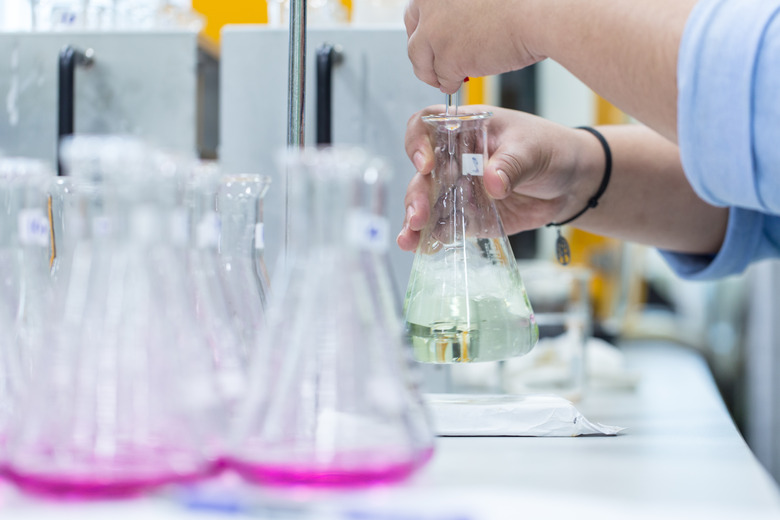How To Find An Equivalence Point Titration
A titration involves the addition of a solution of known concentration (titrant) to a known volume of another solution of unknown concentration (analyte). You add the titrant slowly until the reaction is complete, at which point you can determine the concentration of the unknown solution. Titration reaches the equivalence point (the ideal point of completion) when the reactants have finished reacting, i.e. when the moles of the titrant equal the moles of the analyte.
TL;DR (Too Long; Didn't Read)
You reach equivalence point in titration when the two solutions stop reacting. This is the ideal completion point and is revealed by some kind of indicator, such as a color indicator, when no visible reaction occurs.
Types of Titration
Types of Titration
A combination reaction titration may involve the titration of elements of opposite ions. One ion acts as the titrant while another opposite ion acts as the analyte. Sometimes, a precipitate (an insoluble ionic solid product) forms at the equivalence point. An acid-base titration involves adding an acid or base to the opposite to reach neutralization. Typically, a color change indicator or pH meter signals the equivalence point (neutralization) when there is no visible reaction. In a vinegar titration, you add an indicator solution called phenolphthalein (a pH sensitive organic dye) to the vinegar at the start. Phenolphthalein colorless in acidic solutions (like vinegar) and dark pink in alkaline solutions. At the equivalence point of the vinegar titration, a single drop of sodium hydroxide (the titrant) will turn the entire vinegar solution pale pink.
Titration Equipment
Titration Equipment
To set up a titration, you need an Erlenmeyer flask or beaker, an excess amount of solution of known concentration (titrant), a precisely measured amount of analyte (used to make the solution of unknown concentration), an indicator, a calibrated buret (a glass device that allows the precise delivery of a specific volume of solution) and a buret stand.
Titration Procedure
Titration Procedure
After setting up your titration equipment and measuring your analyte, transfer the analyte into your flask or beaker, making sure any solid analyte is rinsed into the container with distilled water. Add more distilled water until the analyte is completely dissolved. Measure and record the volume of solution. If using a color indicator, add a few drops of it to the container. Gently swirl the container to mix the analyte solution and the indicator. Fill the buret with the titrant and clamp it to the buret stand. (Make sure the tip of the buret doesn't touch any surfaces.) Place the container under the buret and record the initial volume. Open the buret tap to add the titrant to the container. Swirl the container to get rid of the color that appears. Repeat this step until you cannot get rid of the color. This is the equivalence point.
References
Cite This Article
MLA
Gillespie, Claire. "How To Find An Equivalence Point Titration" sciencing.com, https://www.sciencing.com/equivalence-point-titration-6906924/. 22 May 2018.
APA
Gillespie, Claire. (2018, May 22). How To Find An Equivalence Point Titration. sciencing.com. Retrieved from https://www.sciencing.com/equivalence-point-titration-6906924/
Chicago
Gillespie, Claire. How To Find An Equivalence Point Titration last modified March 24, 2022. https://www.sciencing.com/equivalence-point-titration-6906924/
